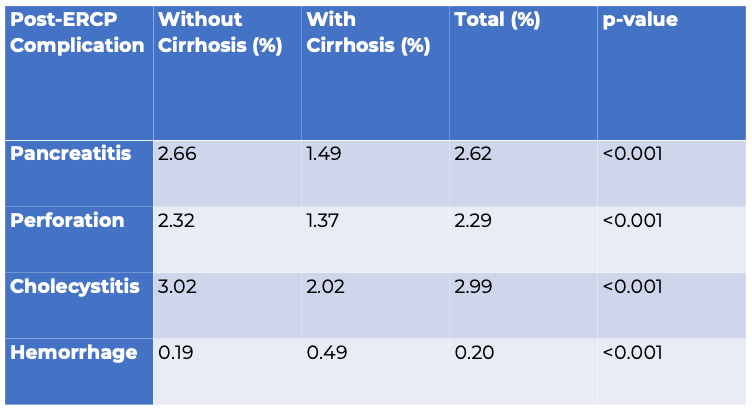Sunday Poster Session
Category: Interventional Endoscopy
P1372 - Inpatient Outcomes of ERCP in Cirrhosis From 2016-2021
Sunday, October 26, 2025
3:30 PM - 7:00 PM PDT
Location: Exhibit Hall

Kelly Fan, MD (she/her/hers)
SSM Health Saint Louis University Hospital
St. Louis, MO
Presenting Author(s)
Kelly Fan, MD, Ryan Plunkett, MD, Garry Francis Morel, MD, Marina Kim, DO
SSM Health Saint Louis University Hospital, St. Louis, MO
Introduction: Endoscopic retrograde cholangiopancreatography (ERCP) is a procedure used to manage a variety of biliary diseases. The procedure carries risks including post-ERCP hemorrhage, perforation, pancreatitis, and cholecystitis. Historical data suggests that patients with cirrhosis who undergo ERCP are at a higher risk for such complications compared to patients without cirrhosis. However, much of the existing data on this topic is extracted from prior to 2016, and few studies have compared the risk of complications in non-cirrhotic patients undergoing ERCP to cirrhotic patients undergoing ERCP. Here, we aim to evaluate the risk of adverse events in patients with and without liver cirrhosis undergoing ERCP in the inpatient setting using recent data from 2016-2021.
Methods: This study used the National Inpatient Sample (NIS) database. We identified adult patients that underwent inpatient ERCP between 2016 and 2021 and stratified them into two groups based on the presence or absence of liver cirrhosis. The rate of multiple complications of ERCP were compared using multivariate regression.
Results: A total of 1,190,835 adult patients were identified who underwent ERCP from 2016-2021; 34,950 of these patients had liver cirrhosis. Adjusting for age, sex, race, and median household income, those with cirrhosis who underwent therapeutic ERCP had a higher rate of post-ERCP mortality (OR = 1.56, p< 0.001). Compared to patients without cirrhosis, patients with cirrhosis had a higher rate of post-ERCP hemorrhage (0.49% vs. 0.19%, p< 0.001). However, patients with cirrhosis who underwent ERCP had statistically lower rates of post-ERCP cholecystitis (2.02% vs. 3.02%, p< 0.001), pancreatitis (1.49% vs. 2.66%, p< 0.001), and perforations (1.37% vs. 2.32%, p< 0.001) compared to patients without cirrhosis.
Discussion: While various studies have explored the rates of post-ERCP complications in patients with and without liver disease, this study offers a clinical update on this topic using a large sample of new data. A limitation to consider is potential selection bias as patients with more advanced liver disease may have been excluded from undergoing ERCP. Overall, the data presented here reinforces prior findings while also offering specific insights into higher mortality and post-ERCP complications in patients with cirrhosis undergoing therapeutic ERCP.

Figure: Table 1. Comparison of post-ERCP complications between patients without and with cirrhosis.
Disclosures:
Kelly Fan indicated no relevant financial relationships.
Ryan Plunkett indicated no relevant financial relationships.
Garry Francis Morel indicated no relevant financial relationships.
Marina Kim indicated no relevant financial relationships.
Kelly Fan, MD, Ryan Plunkett, MD, Garry Francis Morel, MD, Marina Kim, DO. P1372 - Inpatient Outcomes of ERCP in Cirrhosis From 2016-2021, ACG 2025 Annual Scientific Meeting Abstracts. Phoenix, AZ: American College of Gastroenterology.
SSM Health Saint Louis University Hospital, St. Louis, MO
Introduction: Endoscopic retrograde cholangiopancreatography (ERCP) is a procedure used to manage a variety of biliary diseases. The procedure carries risks including post-ERCP hemorrhage, perforation, pancreatitis, and cholecystitis. Historical data suggests that patients with cirrhosis who undergo ERCP are at a higher risk for such complications compared to patients without cirrhosis. However, much of the existing data on this topic is extracted from prior to 2016, and few studies have compared the risk of complications in non-cirrhotic patients undergoing ERCP to cirrhotic patients undergoing ERCP. Here, we aim to evaluate the risk of adverse events in patients with and without liver cirrhosis undergoing ERCP in the inpatient setting using recent data from 2016-2021.
Methods: This study used the National Inpatient Sample (NIS) database. We identified adult patients that underwent inpatient ERCP between 2016 and 2021 and stratified them into two groups based on the presence or absence of liver cirrhosis. The rate of multiple complications of ERCP were compared using multivariate regression.
Results: A total of 1,190,835 adult patients were identified who underwent ERCP from 2016-2021; 34,950 of these patients had liver cirrhosis. Adjusting for age, sex, race, and median household income, those with cirrhosis who underwent therapeutic ERCP had a higher rate of post-ERCP mortality (OR = 1.56, p< 0.001). Compared to patients without cirrhosis, patients with cirrhosis had a higher rate of post-ERCP hemorrhage (0.49% vs. 0.19%, p< 0.001). However, patients with cirrhosis who underwent ERCP had statistically lower rates of post-ERCP cholecystitis (2.02% vs. 3.02%, p< 0.001), pancreatitis (1.49% vs. 2.66%, p< 0.001), and perforations (1.37% vs. 2.32%, p< 0.001) compared to patients without cirrhosis.
Discussion: While various studies have explored the rates of post-ERCP complications in patients with and without liver disease, this study offers a clinical update on this topic using a large sample of new data. A limitation to consider is potential selection bias as patients with more advanced liver disease may have been excluded from undergoing ERCP. Overall, the data presented here reinforces prior findings while also offering specific insights into higher mortality and post-ERCP complications in patients with cirrhosis undergoing therapeutic ERCP.

Figure: Table 1. Comparison of post-ERCP complications between patients without and with cirrhosis.
Disclosures:
Kelly Fan indicated no relevant financial relationships.
Ryan Plunkett indicated no relevant financial relationships.
Garry Francis Morel indicated no relevant financial relationships.
Marina Kim indicated no relevant financial relationships.
Kelly Fan, MD, Ryan Plunkett, MD, Garry Francis Morel, MD, Marina Kim, DO. P1372 - Inpatient Outcomes of ERCP in Cirrhosis From 2016-2021, ACG 2025 Annual Scientific Meeting Abstracts. Phoenix, AZ: American College of Gastroenterology.
